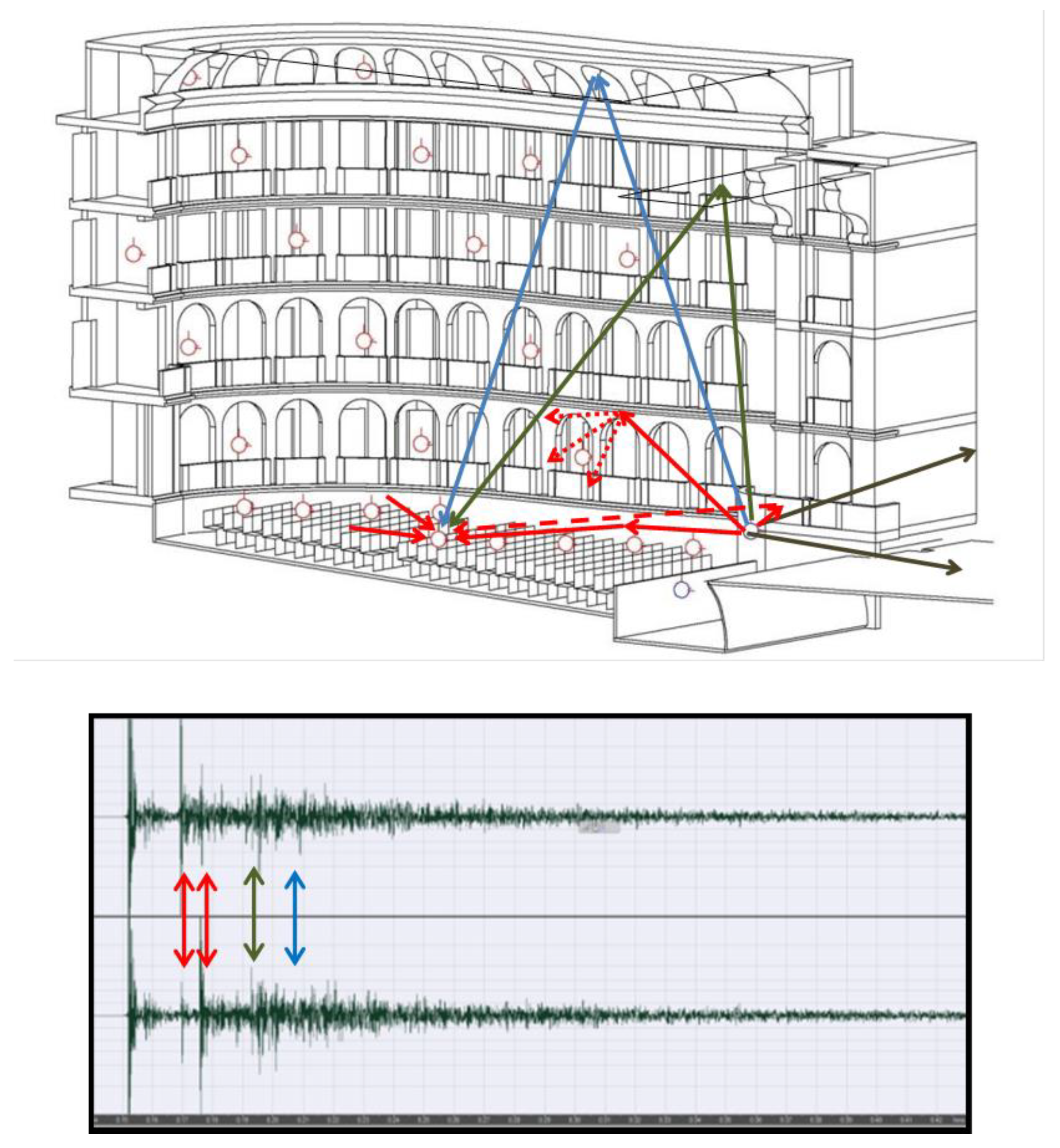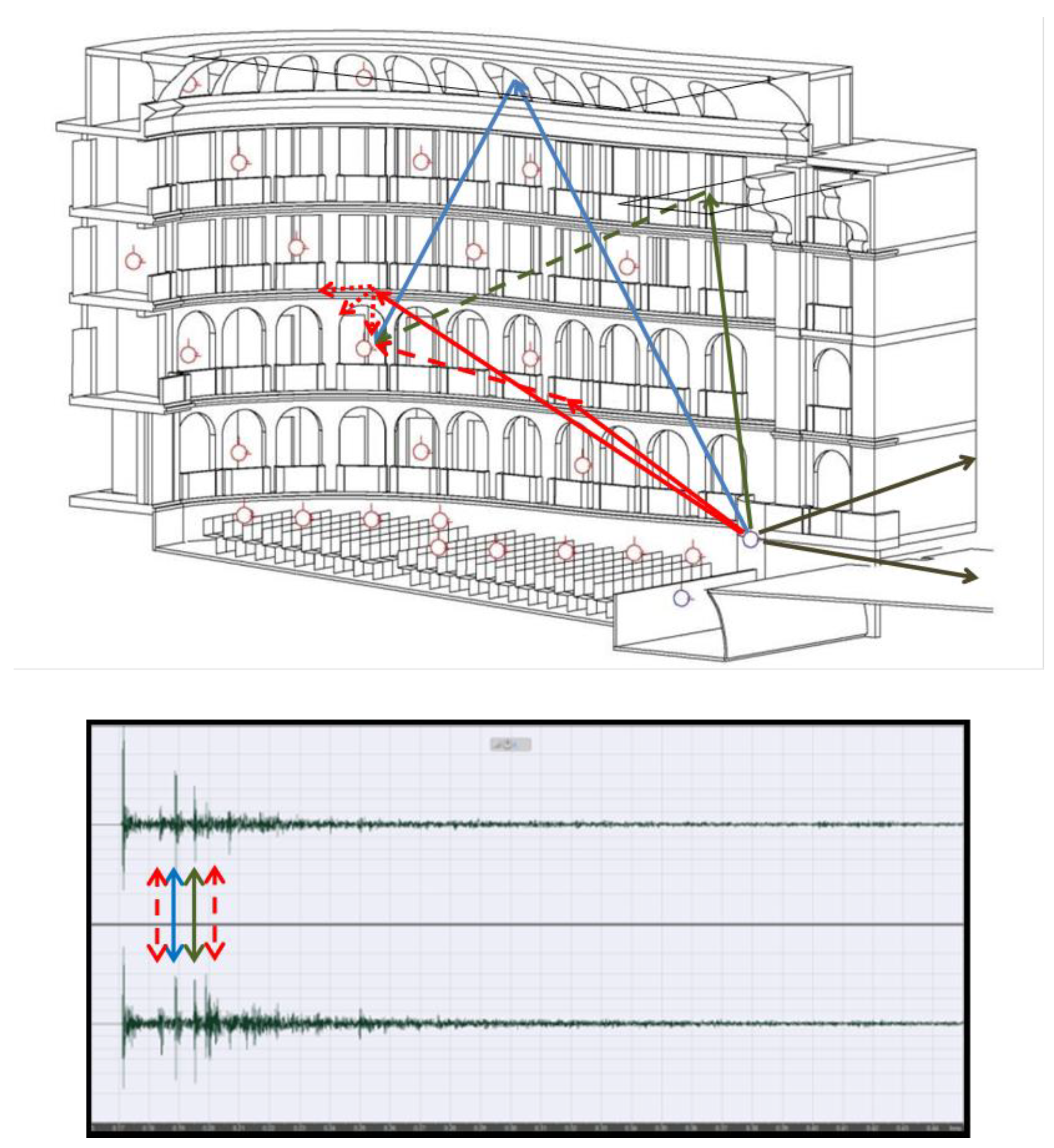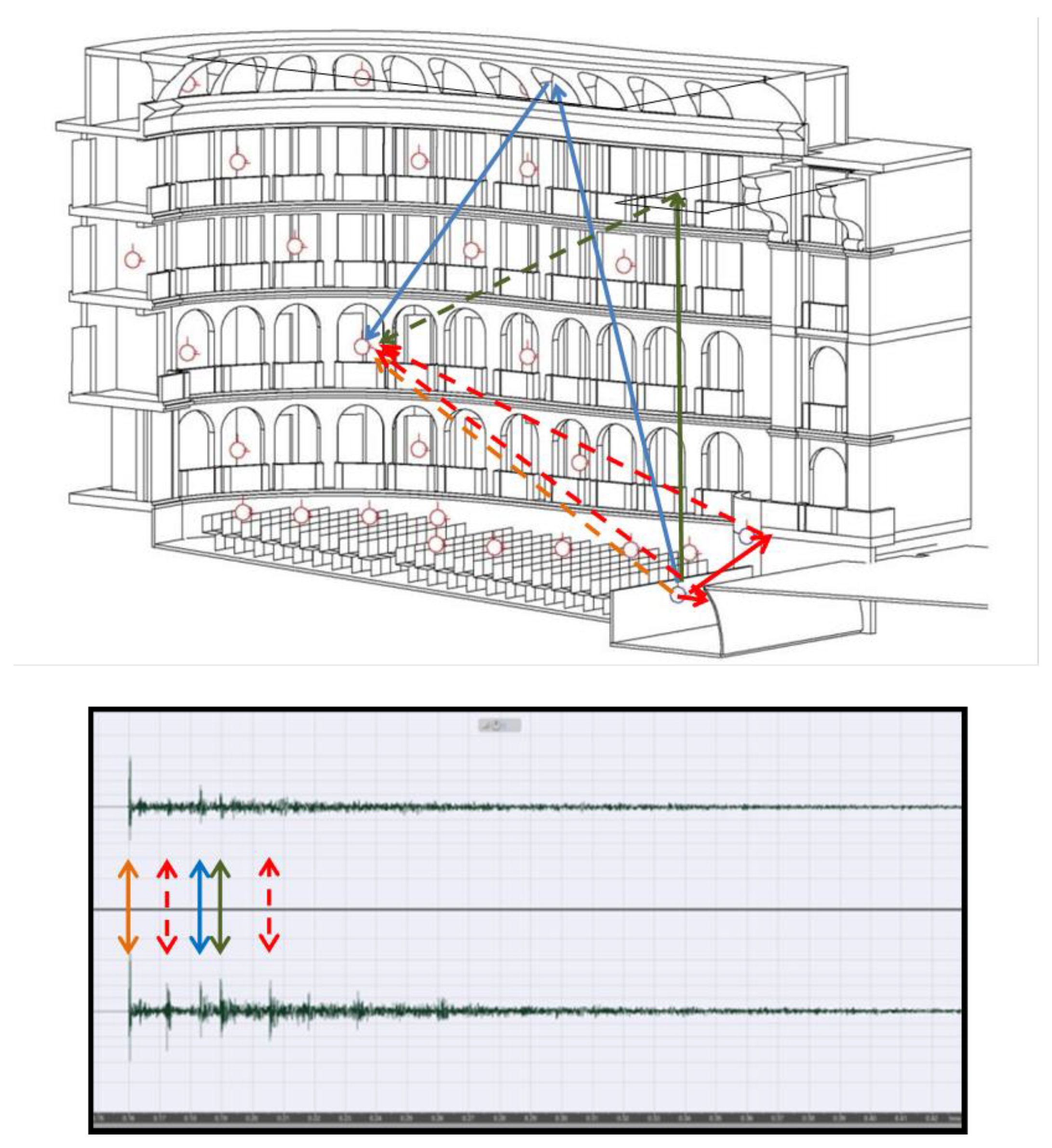From Tangible to Intangible Heritage inside Italian Historical Opera Houses
Abstract
:1. Introduction
2. Why Boxes?
3. The Build-Up of the Acoustical Response in the Hall and the Specific Role of the Surfaces
4. Listening in the Royal and Proscenium Boxes
5. Listening in the Tiers of Boxes
6. The Gallery
7. The Box as a Secondary Sound Source
8. Conclusions
Funding
Conflicts of Interest
References
- Vecco, M. A definition of Cultural Heritage: From the tangible to the intangible. J. Cult. Herit. 2010, 11, 321–324. [Google Scholar] [CrossRef]
- Dordevic, Z. Intangigle tangibility: Acoustical heritage in architecture. Struct. Integr. Life 2016, 16, 59–66. [Google Scholar]
- Fausti, F.; Pompoli, R.; Prodi, N. Acoustics of opera houses: A cultural heritage. J. Soc. Am. 1999, 105, 929. [Google Scholar] [CrossRef]
- Pompoli, R.; Prodi, N. Guidelines for acoustical measurements inside historical opera houses: Procedures and validation. J. Sound Vib. 2002, 232, 281–301. [Google Scholar] [CrossRef]
- Barbieri, P. The acoustics of Italian opera houses and auditoriums (ca. 1450–1900). Recercare 1998, 10, 263–328. [Google Scholar]
- Barbieri, P.; Tronchin, L. L’acustica teatrale nel neoclassicismo italiano. Con una ricostruzione virtuale del ‘teatro ideale’ di Francesco Milizia (1773) (Theatre acoustics in the Italian neoclassical period. With a virtual reconstruction of the ‘ideal theatre’ of Francesco Milizia (1773)). In Giordano Riccati Illuminista Veneto ed Europeo; Fondazione Giorgio Cini—Studi di Musica Veneta; Olschki: Firenze, Italy, 2012; Volume 30, pp. 133–163. [Google Scholar]
- Bianconi, L.; Pestelli, G. (Eds.) Storia Dell’opera Italiana (History of Italian Opera); EDT: Torino, Italy, 1988; Volume 5. [Google Scholar]
- Sorba, C. L’Italia del Melodramma Nell’età del Risorgimento (Italy of Melodramma in the Risorgimento Period); Il Mulino: Bologna, Italy, 2001. [Google Scholar]
- Ianniello, C. A note on historical theaters for opera. Riv. Ital. Acust. 2002, 26, 45–62. (In Italian) [Google Scholar]
- Milizia, F. Trattato Completo, Formale e Materiale del Teatro (Treatise on Theatre); Stamperia Pasquali: Venezia, Italy, 1773. [Google Scholar]
- Prodi, N.; Pompoli, R.; Martellotta, F.; Sato, S. Acoustics of Italian historical opera houses. J. Acoust. Soc. Am. 2015, 138, 769–781. [Google Scholar] [CrossRef] [PubMed]
- Garai, M.; Morandi, F.; D’Orazio, D.; De Cesaris, S.; Loreti, L. Acoustic measurements in eleven Italian opera houses: Correlations between room criteria and considerations on the local evolution of a typology. Build. Environ. 2015, 94, 900–912. [Google Scholar] [CrossRef]
- Sumarac-Pavlovic, D.; Mijic, M.; Masovic, D. The influence of proscenium boxes on acoustic response in historical opera halls (L). J. Acoust. Soc. Am. 2015, 138, 1533–1536. [Google Scholar] [CrossRef] [PubMed]
- Forsyth, M. The relationship between music and architecture in historical theatres. In Teatro Storici: Dal Restauro allo Spettacolo; Nardini: Fiesole, Italy, 1997. (In Italian) [Google Scholar]
- Barron, M. Acoustics of opera houses. In Proceedings of the 2nd International Conference of Acoustics and Spaces for Music CIARM95, Ferrara, Italy, 19–21 May 1995. [Google Scholar]
- International Organization for Standardization. ISO 3382-1:2009 Acoustics—Measurement of Room Acoustic Parameters—Part 1: Performance Spaces; International Organization for Standardization: Geneva, Switzerland, 2009. [Google Scholar]
- Ando, Y. Opera House Acoustics Based on Subjective Preference Theory; Springer: Tokyo, Japan, 2015; Chapter 5. [Google Scholar]
- Sato, S.; Wang, S.; Zhao, Y.; Wu, S.; Sun, H.; Prodi, N.; Visentin, C.; Pompoli, R. Effects of Acoustic and Visual Stimuli on Subjective Preferences for Different Seating Positions in an Italian Style Theater. Acta-Acust. United Acust. 2012, 98, 749–759. [Google Scholar] [CrossRef]
- Beranek, L. Concert Halls and Opera Houses, 2nd ed.; Springer: New York, NY, USA, 2004; Chapter 4. [Google Scholar]
- Sakai, H.; Prodi, N.; Pompoli, R.; Ando, Y. Temporal and spatial acoustical factors for listeners in boxes in an historical opera theatre. J. Sound Vib. 2002, 258, 527–547. [Google Scholar] [CrossRef]
- Available online: http://pcfarina.eng.unipr.it/Public/Presentations/confrontoauditoriumregio.pdf (accessed on 30 January 2019).
- Pisani, R.; Duretto, F. Il restauro ed i problemi di acustica dei teatri storici (The restoration and the acoustics problems in historical theatres). In Proceedings of the XXVII National Conference of the Italian Acoustics association (AIA), Genova, Italy, 26–28 May 1999. [Google Scholar]
- Iannace, G.; Ianniello, C.; Maffei, L.; Romano, R. The acoustics of the Court Theater in the Reggia di Caserta. In Proceedings of the 17th International Congress on Acoustics, Rome, Italy, 2–7 September 2001. [Google Scholar]
- Prodi, N.; Santoni, A.; Rossetti, A. Misurazioni Acustiche nel Teatro Zandonai di Rovereto dopo il Restauro (Acoustical Measurements in the Teatro Zandonai after the Restoration Works); Technical Report; Engineering Department, University of Ferrara: Ferrara, Italy, 2014. [Google Scholar]
- Prodi, N.; Pompoli, R. Acoustics in the restoration of Italian historical opera houses: A review. J. Cult. Herit. 2016, 21, 915–921. [Google Scholar] [CrossRef]
| 1 | The binaural impulse responses are the best acoustical data to represent the sound inputs to the left and right ears of a listener. They are shown in pairs with the left channel above and the right channel below. Binaural data are obtained by means of a so-called “dummy head”, which is an anthropometric sound probe having two microphones close to the entrance or inside the left and right ear canals. |
| 2 | This quantity is termed IACC, is defined in [16] and is bound in the interval [0;1]. It is a measure of the similarity of the signal at the two ears which is thought to be related to the spatial impression intended as both the “apparent source width” and “envelopment” [17]. In the historical opera house this quantifier can be measured and evaluated from binaural impulse responses taken at the listener position for a given sound source location. |




© 2019 by the author. Licensee MDPI, Basel, Switzerland. This article is an open access article distributed under the terms and conditions of the Creative Commons Attribution (CC BY) license (http://creativecommons.org/licenses/by/4.0/).
Share and Cite
Prodi, N. From Tangible to Intangible Heritage inside Italian Historical Opera Houses. Heritage 2019, 2, 826-835. https://doi.org/10.3390/heritage2010054
Prodi N. From Tangible to Intangible Heritage inside Italian Historical Opera Houses. Heritage. 2019; 2(1):826-835. https://doi.org/10.3390/heritage2010054
Chicago/Turabian StyleProdi, Nicola. 2019. "From Tangible to Intangible Heritage inside Italian Historical Opera Houses" Heritage 2, no. 1: 826-835. https://doi.org/10.3390/heritage2010054
APA StyleProdi, N. (2019). From Tangible to Intangible Heritage inside Italian Historical Opera Houses. Heritage, 2(1), 826-835. https://doi.org/10.3390/heritage2010054




